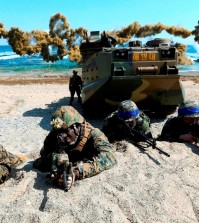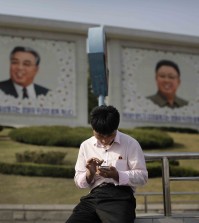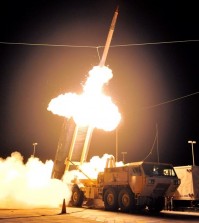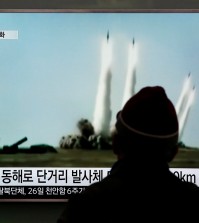- California Assembly OKs highest minimum wage in nation
- S. Korea unveils first graphic cigarette warnings
- US joins with South Korea, Japan in bid to deter North Korea
- LPGA golfer Chun In-gee finally back in action
- S. Korea won’t be top seed in final World Cup qualification round
- US men’s soccer misses 2nd straight Olympics
- US back on track in qualifying with 4-0 win over Guatemala
- High-intensity workout injuries spawn cottage industry
- CDC expands range of Zika mosquitoes into parts of Northeast
- Who knew? ‘The Walking Dead’ is helping families connect
Pentagon denounces NK’s submarine missile test as ‘blatant’ violation of UN resolutions

This undated picture released from North Korea’s official Korean Central News Agency (KCNA) on June 16, 2014 shows North Korean leader Kim Jong-Un (R) inspecting the submarine No. 748 of Korean People’s Army (KPA) naval unit 167 led 7th regiment at an undisclosed location in North Korea (KCNA/Yonhap)
WASHINGTON, May 11 (Yonhap) — The U.S. Defense Department on Monday denounced North Korea’s test-firing of a submarine-launched ballistic missile as a “blatant violation” of U.N. Security Council resolutions and an example of Pyongyang’s unwillingness to comply with international rules.
“Any type of launch of this nature would violate at least four U.N. Security Council resolutions and it is another example of North Koreans’ unwillingness to play by the international rules,” Pentagon spokesman Army Col. Steve Warren said during a regular briefing.
“And as always, we call on North Korea to contribute to stability and not to detract from it,” he said.
North Korea claimed Saturday that leader Kim Jong-un oversaw a successful underwater test-launching of a “strategic submarine ballistic missile.” The test, if confirmed, would represent a significant step forward in the North’s missile technology.
Warren, however, declined to comment on whether the alleged test did happen, citing intelligence matters.
“But again, to reiterate, any test of this type would be a blatant violation of several Security Council resolutions,” he said.
The North’s test, coupled with its launching Saturday of three ship-to-ship missiles into the East Sea, could rekindle debates in South Korea about whether the country should accept an advanced missile defense system from the U.S., known as THAAD (Terminal High Altitude Area Defense).
Warren declined to comment on whether THAAD is capable of defending against North Korean SLBMs, saying he won’t “get into technical capabilities of our missile defense systems.”
South Korea’s defense ministry described the North’s SLBM launch as “very serious and worrying,” and urged Pyongyang to cease the development of such missiles, even though officials said the missile appeared to have flown only about 100 or 150 meters from the surface of the water.
The North’s SLBM, if developed, would pose a serious threat because its mobile nature would make it very difficult to detect signs of a launch in advance. The North’s new road-mobile intercontinental ballistic missile, KN-08, has also been a serious concern to the U.S.
Victor Cha, chief Korea analyst at the Center for Strategic and International Studies, said the North’s test of a submarine ballistic missile shows the country’s “missile capabilities are advancing at a clip that is concerning, if not alarming.”
The expert also noted Admiral William Gortney’s remarks last month that North Korea is capable of building a nuclear weapon small enough to fit atop the KN-08 missile and firing it at the U.S. mainland.
“It is clear that North Korea is not just trying to develop a crude nuclear device that it could put atop a missile for some sort of rudimentary deterrent purpose,” Cha said. “The North is moving headlong toward the development of a modern, survivable nuclear deterrent, with the full range of capacity from battlefield nuclear forces to high-yield fission and fusion weapons.”
















Pingback: North Korea's submarine missile firing raises the nuclear stakes | Em News
Pingback: North Korea’s Submarine Missile Firing Raises the Nuclear Stakes
jammy
November 5, 2017 at 1:25 AM
December 2017 Printable calendar